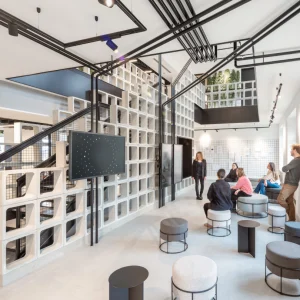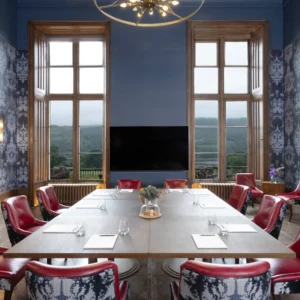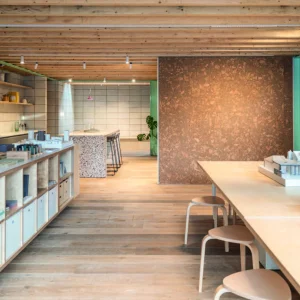ID:SR, the interior design team at UK-based architectural practice Sheppard Robson, has completed the design project and has relocated 2,500 staff from 26 separate locations into 1,800 desk spaces.
The new 23,000 square meter local authority offices at Building 1000 in the Royal Albert Docks, London, occupy eight floors. The challenge was to move the staff to the building from disparate locations – temporary cabins and old town halls – to provide a cohesive office with limited desk space.
ID:SR’s design solution took the concept of neighborhoods, creating a dense-urban rather than sprawling-suburban setting in the new workplace. The compact areas of desking have been combined with high-quality shared spaces for meetings, break-out and refreshments, taking up 30% of the floor-plate.
ID:SR defined the neighborhood concept throughout the workspace: ‘Cityscape’, ‘Parklife’, ‘Town square’ ‘Study Space’ and ‘Living Room’. The Cityscape is created with timber ribbon that wraps up, over and around the more intimate living room and study spaces. The structured urban form contrasts the variety of wallpaper patterns in jewel-like colors that clad the interiors of the rooms.
The ribbon creates a natural screen to the more private desk clusters. Parklife provides an informal, reflective place with a soft interior landscape encouraging staff interaction. The offices are designed as a diverse range of places to suit Newham’s varying activities, creating a synergy between the neighborhood in the office and the Borough it supports.
The staff wanted curved desk clusters, but this would only accommodate 198 people per floor, compared to 240 if they used straight lines of desks. ID:SR brought them around with the neighborhood concept, arranging teams at either end of the floor-plate, divided by the ‘Town Square’ central shared area.
Helen Berresford, head of ID:SR and lead designer for the Newham offices, comments, “In terms of cost savings and efficiency, Newham’s new offices have become a benchmark for public sector workspace. People do not only work individually, they also undertake collaborative tasks. Sharing desk space frees up 25% of the office floor-plate for the various neighborhood zones.”





